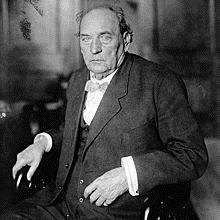
United States Senator from Alabama John Hollis Bankhead (1842-1920) served from 1907 to 1920. During his career in the Senate he was instrumental in the Good Roads effort to bring highways and all-weather roads to farmers throughout the country. The Bankhead Highway running from Texarkana to El Paso is an example of his greatest accomplishment.
Have you ever driven on the Bankhead Highway? Probably you have but just weren’t aware of it. The Bankhead Highway was the second transcontinental road in the United States; the first completely paved from East Coast to West Coast and came right through downtown Commerce and downtown Greenville. An earlier Lincoln Highway went from Washington, D. C. to San Francisco. It was an improved roadway financed with local funds, was impassable in winter, and crossed some of the highest peaks in the Rocky Mountains. In other words, it had a few too many drawbacks.
In 1916 Senator John Hollis Bankhead of Alabama spearheaded a movement to create a federally funded paved highway crossing the south from the South Lawn of the White House to San Diego. It provided year-round roads with lower grades; no mountains were crossed. The highway went south from the nation’s capital through Virginia to Georgia, turned west through Alabama and Mississippi, before following the Mississippi River to Memphis where it headed southwesterly through Arkansas into Texas. The All Texas Route, as it became known, traveled through Texarkana, Sulphur Springs, Commerce, Greenville, Dallas, Abilene, and Pecos into El Paso. From there it was almost a straight shot westward to San Diego. Along the way were a few Scenic Routes, such as the one that traveled across portions of Oklahoma and New Mexico.
The road was promoted as a means to boost rural economies at a time when it was desperately needed. Cities, towns, hotels, and diners all jumped on board when they realized the economic advantages of the new class of motoring tourists in the United States.
The Bankhead Highway was officially State Highway 1 in Texas and also known as Broadway of America all across its route. At Sulphur Springs the road turned northeast and followed what is today Highway 11. In Commerce, State Highway 1 later became Highway 24 or 224 today. It entered Greenville on North Stonewall Street, passing the “filling station” still standing just before the square. There it turned west along Lee Street, often referred to in advertisements of the Beckham Hotel as Broadway of America. After it crossed the Katy tracks it turned south on what is now Wellington Street. At the old gas station it turned west onto O’Neal Street. That street makes a southwesterly curve. From that point the route is rather blurred to me.
However, there were alternate routes through the Black Lands of Texas and Mississippi to avoid the swampy conditions in wet seasons. In 1920 the War Department moved a convoy of fifty trucks and jeeps across the country to publicize its part in the victory in Europe. Deciding that trucks loaded with tanks were too heavy for the established Bankhead Highway, they went from Mount Vernon to Paris and Sherman before turning south through McKinney and into Dallas. That route covers higher ground and less likelihood of getting stuck in the mud.
In 1921 W. Walworth Harrison took his mother and two female cousins on a road trip to California. It took almost all summer. Harrison kept a detailed journal that is in the Greenville library named for him. The most interesting thing I found was that when he left Greenville, he drove to Farmersville and McKinney before turning south the pick up the official Bankhead Highway in Dallas. I know the road went through downtown Garland and probably passed through Rockwall, but why go out of the way to McKinney. I suspect the road was like pioneer roads, it pointed you in the right direction with no off-ramps and tollbooths to guide your drive.
